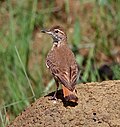Superregnum: Eukaryota
Regnum: Animalia
Subregnum: Eumetazoa
Cladus: Bilateria
Cladus: Nephrozoa
Superphylum: Deuterostomia
Phylum: Chordata
Cladus: Craniata
Subphylum: Vertebrata
Infraphylum: Gnathostomata
Superclassis: Tetrapoda
Cladus: Reptiliomorpha
Cladus: Amniota
Classis: Reptilia
Cladus: Eureptilia
Cladus: Romeriida
Subclassis: Diapsida
Cladus: Sauria
Infraclassis: Archosauromorpha
Cladus: Crurotarsi
Divisio: Archosauria
Subsectio: Ornithodira
Subtaxon: Dinosauromorpha
Cladus: Dinosauria
Ordo: Saurischia
Cladus: Theropoda
Cladus: Neotheropoda
Infraclassis: Aves
Ordo: Passeriformes
Subordo: Tyranni
Infraordo: Tyrannides
Parvordo: Furnariida
Superfamilia: Furnarioidea
Familia: Furnariidae
Subfamilia: Sclerurinae
Genus: Geositta
Species (12): G. antarctica – G. crassirostris – G. cunicularia – G. isabellina – G. maritima – G. peruviana – G. poeciloptera – G. punensis – G. rufipennis – G. saxicolina – G. tenuirostris
Name
Geositta Swainson, 1837
Typus
Alauda cunicularia Vieillot, 1816 = Geositta cunicularia
Synonyms
Geobates Swainson, 1838
Geobamon Burmeister, 1860
Geocitta P.L. Sclater, 1862 [variation]
References
Primary references
Swainson, W.J. 1837. On the natural history and classification of birds. The Cabinet Cyclopæedia. Natural History. 2: 398 pp. Longman, Rees, Orme, Brown, Green, & Longman & John Taylor. London. BHL Reference page. Original description p.317 fig.283 BHL
References
Cheviron, Z.A.; Capparella, A.P. & Vuilleumier, F. 2005. Molecular phylogenetic relationships among the Geositta miners (Furnariidae) and biogeographic implications for avian speciation in Fuego-Patagonia. The Auk 122: 158-174. DOI: 10.1642/0004-8038(2005)122[0158:MPRATG]2.0.CO;2Reference page.
Derryberry, E., Claramunt, S., Derryberry, G., Chesser, R.T., Cracraft, J., Aleixo, A., Pérez-Emán, J., Remsem, Jr, J.V. & Brumfield, R.T. 2011. Lineage diversification and morphological evolution in a large-scale continental radiation: the Neotropical ovenbirds and woodcreepers (Aves: Furnariidae). Evolution 65: 2973–2986. DOI: 10.1111/j.1558-5646.2011.01374.x Full article (PDF). Reference page.
Geositta is a genus of passerine birds in the ovenbird family, Furnariidae. They are known as miners (not to be confused with the unrelated miners, Manorina, of Australia) due to the tunnels they dig for nesting. There are 11 species including the campo miner (Geositta poeciloptera) which was formerly classified in a genus of its own, Geobates. They inhabit open country in South America, particularly the Andean and Patagonian regions. They are ground-dwelling birds, somewhat resembling the larks and wheatears of other continents. They are mostly drab brown in coloration and often have a fairly long and slender bill.
Species list
The genus contains 11 species:[1]
| Image | Scientific name | Common Name | Distribution |
|---|---|---|---|
 |
Geositta peruviana | Coastal miner | Peru. |
 |
Geositta cunicularia | Common miner | Chile, Argentina and Uruguay, parts of Peru and Bolivia and in southernmost Brazil. |
 |
Geositta tenuirostris | Slender-billed miner | Argentina, Bolivia, Chile, Ecuador, and Peru. |
| Geositta antarctica | Short-billed miner | Santa Cruz Province and Tierra del Fuego | |
| Geositta isabellina | Creamy-rumped miner | Argentina and Chile. | |
 |
Geositta saxicolina | Dark-winged miner | Peru. |
 |
Geositta maritima | Greyish miner | Chile and Peru |
 |
Geositta punensis | Puna miner | Argentina, Bolivia, Chile, and Peru. |
 |
Geositta rufipennis | Rufous-banded miner | Argentina, Bolivia, and Chile. |
 |
Geositta poeciloptera | Campo miner | Brazil and far northeastern Bolivia |
 |
Geositta crassirostris | Thick-billed miner | Peru. |
References
Gill, Frank; Donsker, David, eds. (2019). "Ovenbirds, woodcreepers". World Bird List Version 9.1. International Ornithologists' Union. Retrieved 22 January 2019.
Jaramillo, Alvaro; Burke, Peter & Beadle, David (2003) Field Guide to the Birds of Chile, Christopher Helm, London
South American Classification Committee (2007) A classification of the bird species of South America, part 6. Retrieved 08/06/07.
Retrieved from "http://en.wikipedia.org/"
All text is available under the terms of the GNU Free Documentation License

